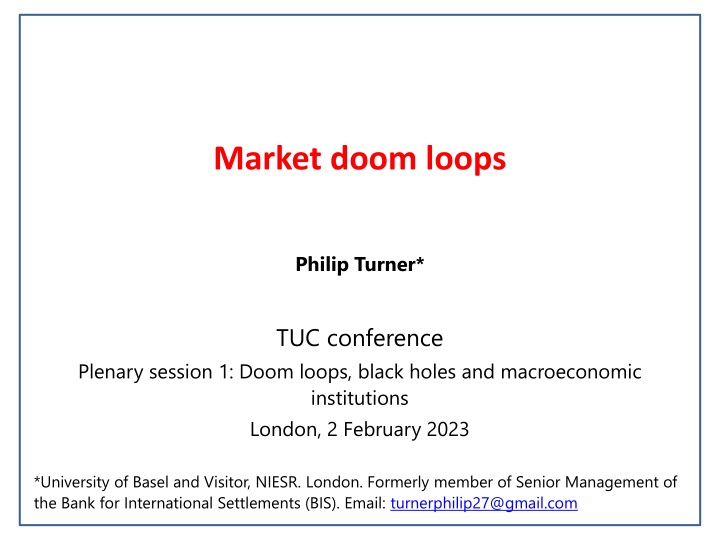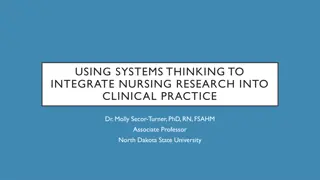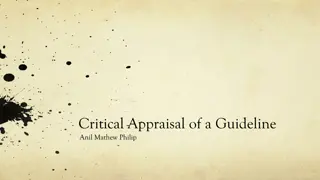
Market Doom Loops and Macroeconomic Institutions Overview
Explore the interplay of market doom loops and macroeconomic institutions through case studies such as bond market vigilantes and fiscal austerity. Discover the impact of monetary policy responses on fiscal decisions and the consequences of below-target inflation and excess unemployment. Gain insights into the risks posed by the wrong policy mix and regulatory influences on the financial system.
Download Presentation

Please find below an Image/Link to download the presentation.
The content on the website is provided AS IS for your information and personal use only. It may not be sold, licensed, or shared on other websites without obtaining consent from the author. If you encounter any issues during the download, it is possible that the publisher has removed the file from their server.
You are allowed to download the files provided on this website for personal or commercial use, subject to the condition that they are used lawfully. All files are the property of their respective owners.
The content on the website is provided AS IS for your information and personal use only. It may not be sold, licensed, or shared on other websites without obtaining consent from the author.
E N D
Presentation Transcript
Market doom loops Philip Turner* TUC conference Plenary session 1: Doom loops, black holes and macroeconomic institutions London, 2 February 2023 *University of Basel and Visitor, NIESR. London. Formerly member of Senior Management of the Bank for International Settlements (BIS). Email: turnerphilip27@gmail.com
Bond market vigilantes Clinton Administration, 1993/94 Yield10-year US Treasuries: 5% in Oct 1993 to 8% in Nov 1994 Signal for the US to tighten fiscal policy? Not necessarily: 3 percentage points rise in Fed funds in year to Feb 1995 ( to keep ahead of rises in the bond market ) Two conclusions 1. Doom loops result from the wrong policy response to market signals. 2. When monetary policy turns restrictive, bond market signals can send fiscal policy in the wrong direction.
Fiscal austerity and (radical) monetary ease 2010 to 2019 A decade of monetary expansion and fiscal contraction. Crisis broke in August 2007 but decisive action taken only after Lehman failure in September 2008. After that, central banks boldly used new tools at scale a valuable lesson about the paradox of risk Jeremiahs who predicted inflation or financial ruin proved wrong ... the doom loop successfully blocked (Turner (2021)).
Below-target inflation and excess unemployment 2010 to 2019 US core inflation averages 1.6%: inflation below predictions . Forecasts of year-ahead 10-year bond yield: upward bias. Fed estimates that the equilibrium real interest rate (r*) had fallen to 0-1% compared with 2-3% in the 1990s. For too long, policy rates were above this natural rate . A recent US study found monetary policy in advanced economies was unintentionally too tight -- 25 years of excess unemployment (Gagnon and Sarsenbayev (2022)).
The wrong policy mix Monetary expansion = ??????? ???? Fiscal expansion = ?????? ???? Liabilities. Higher private debt/GDP ratios make households and companies more vulnerable in a recession. Assets. Banks, pension funds, insurance companies etc search for higher yields from riskier or illiquid asset and buy their prime safe assets (government bonds) at inflated prices. Excessive reliance on monetary policy and very depressed long-term interest rates made the financial system and the real economy more fragile
Regulators also depress the long-term interest rate Regulators induce financial firms to de-risk and hold more safe government bonds, but turn a blind eye to what will happen when interest rates rise: Banks face no capital charge for interest rate risk in Basel III. Borrowers raise more funds in bond markets. Non-bank financial investors (hedge funds, investment funds, pension funds etc ) create a shadow banking system and G7 countries do not agree on how to regulate. Financial firms exposures in bond markets are large, highly leveraged and opaque The first bodies to float to the surface are UK pension funds but the underlying predicament is shared globally.
Why did no one see it coming? At every stage, someone was relying on somebody else and everyone thought they were doing the right thing. Since the 1990s, a deliberate fragmentation of responsibility for economic policy: each agency accountable , often with simplistic rules: Fiscal: Debt/GDP target. In UK, Treasury projections and OBR verification Monetary: An inflation target of 2% MPC Regulatory: Banks follow Basel III ... FPC for financial stability Are any of these broad-brush objectives being achieved today?
Operational independence BUT accountability is essential Effective policy requires insulation from political accidents Agencies explain publicly in detail what they are doing and why Agencies explain mistakes Open to challenge and to Parliamentary review Much to praise in how many UK institutions have worked under pressure
Inflation surge and the Great Monetary Tightening Inflation and the monetary policy reaction uncertain. Demand stimulus. Biden fiscal stimulus. Extreme monetary ease. Reduced supply. Post-COVID shortages of goods and labour, China shutdown, war in Ukraine The Great Monetary Tightening. Led by the Federal Reserve sharpest since 1994/5 Shadow Fed funds rate converts balance sheet expansion to the Fed funds equivalent: COVID-19 balance sheet stimulus larger but shorter than in GFC. From March 2021, the end of asset purchases + (later) higher Fed funds = very sharp rise in the shadow rate
Figure 1 Fed funds rate and shadow Fed funds rate 8.0 6.0 4.0 2.0 Percent 0.0 -2.0 -4.0 -6.0 -8.0 -10.0 2007 2008 2009 2010 2011 2012 2013 2014 2015 2016 2017 2018 2019 2020 2021 2022 Shadow FFR Federal Funds Rate Source: Federal Reserve Board and Lombardi and Zhu (2014 and 2018) updated 10
Central banks ready for an interest rate shock? Policy mistakes from neglect of policy linkages. From mid-2021 (10-year bonds yielding 0.8%) the Bank of England continued to buy bonds unnecessarily. The Treasury did not seize the opportunity to limit future interest payments. Neglect of fiscal/monetary policy linkages(Turner (2022). FPC fails to address the financial vulnerabilities that any sharp rise in long-term interest rates would reveal. Neglect of financial stability/monetary policy linkages. Basel III delayed, diluted, fragmented Non-banks. International regulatory vacuum despite huge efforts
Reading global bond markets Monetary tightening is global but $ dominated Bond market vigilantes indulgent. The world real interest rate has risen but still moderate (Misev and Turner (2022)). Long-run expectations of policy rates. Higher but suggest the natural rate of interest will remain low. Credibility. Central banks have market confidence that inflation will return to target Interest rate risks on the balance sheets of banks and other financial firms. Large and opaque: no good measures of aggregate interest rate risk Global credit supply. Post-COVID decline in credit/GDP but still holding up, Sharp contraction in credit in the UK points to very weak growth Uncertainty about the peak in interest rates, the eventual impact on credit supply and the fragility of the financial system.
Credit to households and non-financial companies As a % of GDP United Kingdom 162.3 Euro area 163.2 167.2 + 4.0 United States 152.5 155.1 + 2.6 2017 2022 Q2 Change 150.2 - 12.1 Source: BIS
Conclusion Central banks have not prepared financial firms for the Great Monetary Tightening. Threat of doom loops often lie in the fiscal/monetary/regulatory feedback effects even when each policy looks OK. Therefore key policy bodies the Treasury, the central bank and the financial regulators must look beyond their immediate mandates. The current institutional set-up in the UK needs to better address such feedbacks, which are accentuated in a financial crisis.
References H rdahl, P J Sobrun and P Turner (2016): Low long-term interest rates as a global phenomenon . BIS Working Papers, no 574. August Gagnon, J E and M Sarsenbayev (2022): 25 years of excess unemployment in advanced economies: lessons for monetary policy PIIE Working Paper https://www.piie.com/publications/working-papers/25-years-excess- unemployment-advanced-economies-lessons-monetary-policy Lombardi, M J. and F Zhu (2014 and 2018): A shadow policy rate to calibrate US monetary policy at the Zero Lower Bound BIS 15 no 452 (June 2014) and International Journal of Central Banking December 2018. Misev, M and P Turner (2022): Is a bond market crisis likely? Central Banking Journal vol XXXII. Pp 52-57. June Turner, P: (2021): The new monetary policy revolution: advice and dissent. NIESR Occasional Paper no 60 https://www.niesr.ac.uk/wp- content/uploads/2021/10/New-Monetary-Policy-Revolution_0-4.pdf --- (2022): Interest rate risk, monetary policy and the threat of financial crisis. Macroprudential Matters. October. https://macroprudentialmatters.com/interest- rate-risk-monetary-policy-and-the-threat-of-financial-crisis/






















